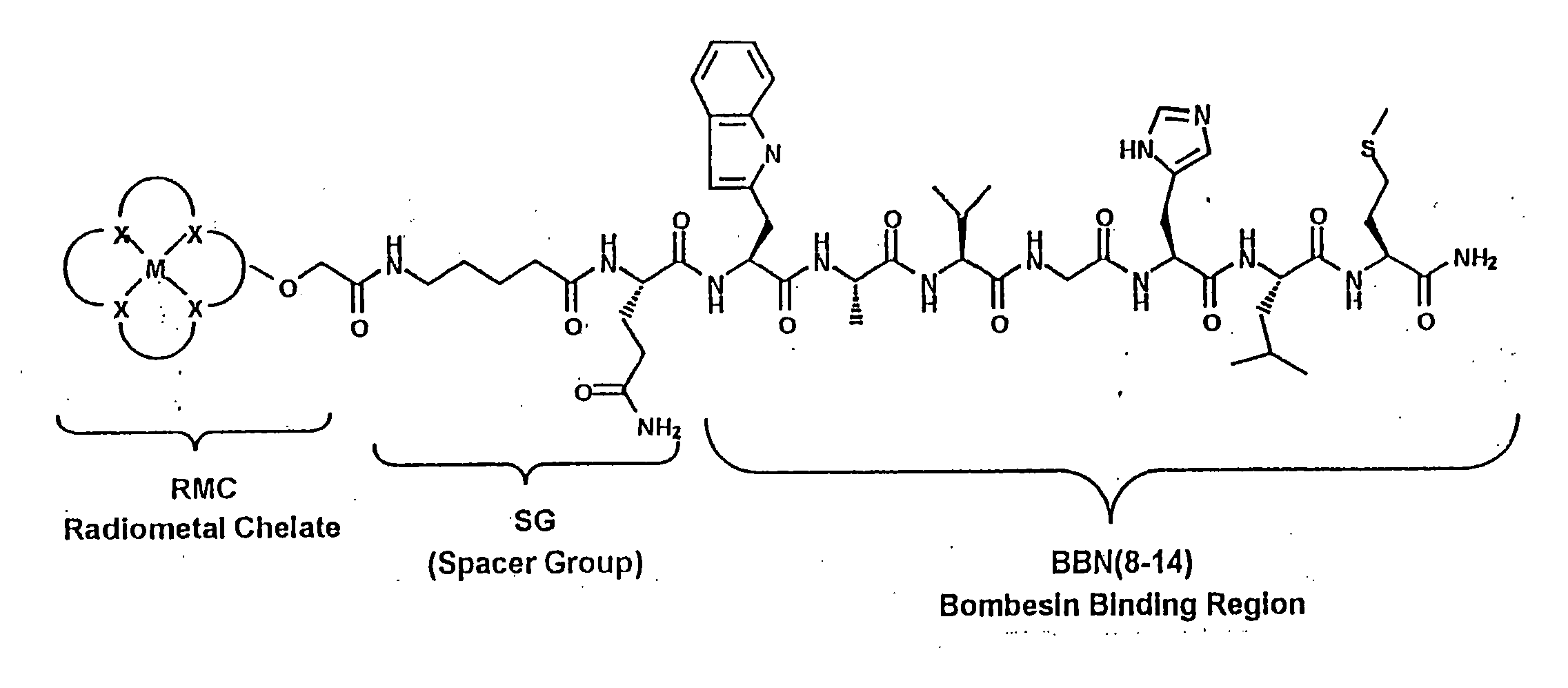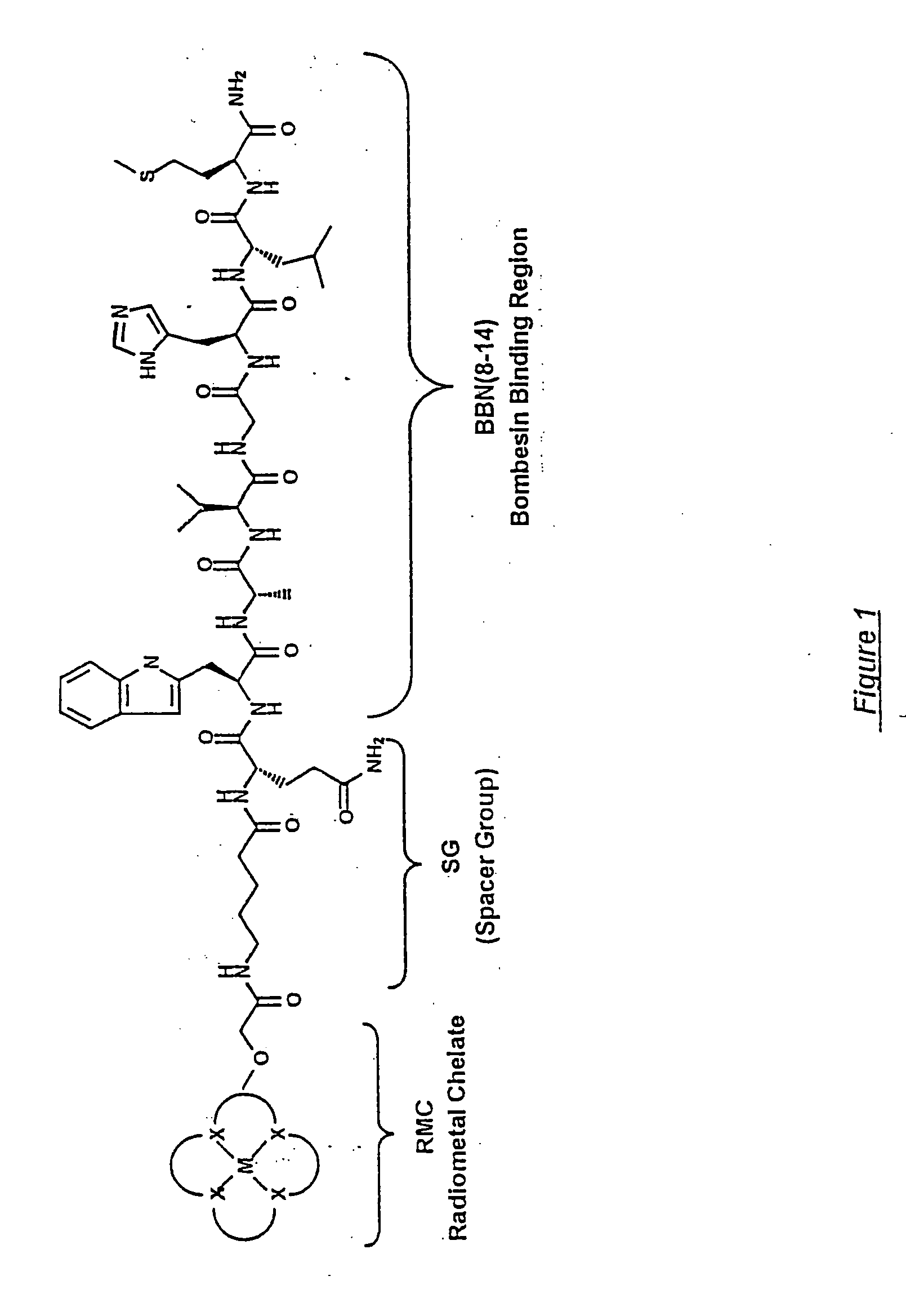Gastrin receptor-avid peptide conjugates
a peptide and receptor technology, applied in the field of radionuclide-labeled compounds, can solve the problems of limited number of site-directed radiopharmaceuticals, low probability of remaining “trapped", and excessive radiation dose to the kidneys
- Summary
- Abstract
- Description
- Claims
- Application Information
AI Technical Summary
Benefits of technology
Problems solved by technology
Method used
Image
Examples
example 1
Synthesis and In Vitro Binding Assessment of Synthetic BBN Analogues Employing Hydrocarbon Chain Spacers
[0097] A. Synthesis:
[0098] Many BBN analogues were synthesized by Solid Phase Peptide Synthesis (SPPS). Each peptide was prepared by SPPS using an Applied Biosystems Model 432A peptide synthesizer. After cleavage of each BBN analogue from the resin using Trifluoracetic acid (TFA), the peptides were purified by C18 reversed-phase HPLC using a Vydac HS54 column and CH3CN / H2O containing 0.1% TFA as the mobile phase. After collection of the fraction containing the desired BBN peptide (approx. 80-90% yield in most cases), the solvent was evaporated. The identity of each BBN peptide was confirmed by FAB-mass spectrometry, Department of Chemistry—Washington University, St. Louis, Mo.
[0099] Various amino acid sequences (in some cases including different chemical moieties) were conjugated to the N-terminal end of the BBN binding region (i.e., to BBN-8 or Trp8). BBN analogue numbers 9, 1...
example 2
Retention of 105Rh-BBN Analogues in Cancer Cells
[0111] Once the radiometal has been specifically “delivered” to cancer cells (e.g., employing the BBN binding moiety that specifically targets GRP receptors on the cell surface), it is necessary that a large percentage of the “delivered” radioactive atoms remain associated with the cells for a period time of hours or longer to make an effective radiopharmaceutical for effectively treating cancer. One way to achieve this association is to internalize the radiolabeled BBN conjugates within the cancer cell after binding to cell surface GRP receptors.
[0112] In the past, all of the work with synthetic-BBN analogues for treatment of cancers focused on synthesizing and evaluating antagonists [Davis et al., 1992; Hoffken, 1994; Moody et al., 1996; Coy et al., 1988; Cai et al., 1994; Moody et al., 1995; Leban et al., 1994; Cai et al., 1992]. After evaluating synthetic BBN analogues that would be predicted to be either agonists or antagonists,...
example 3
Human Cancer Cell Line Studies
[0118] In vitro cell binding studies of 105Rh-BBN-37 with two different human cancer cell lines that express GRP receptors (i.e., CF-PAC1 and PC-3 cell lines), which are tumor cells derived from patients with prostate CA and pancreatic CA, as shown in FIGS. 17A-B and 18A-B, respectively) were performed. Results of these studies demonstrated consistency with 105Rh-BBN-37 binding and retention studies using Swiss 3T3 cells. Specifically, the binding affinity of Rh-BBN-37 was high (i.e., IC50≅7 nM) with both human cancer cell lines as shown in Table 1. In addition, in all cells, the majority of the 105Rh-BBN-37 was internalized and perhaps a major unexpected result was that the retention of the 105Rh-tracer inside of the cells was significantly better than retention in Swiss 3T3 cells as shown in FIGS. 17 and 18. For example, it is particularly remarkable that the percentage of 105Rh-BBN-37 that remained associated with both the CFPAC-1 and PC-3 cell line...
PUM
| Property | Measurement | Unit |
|---|---|---|
| Molar density | aaaaa | aaaaa |
| Molar density | aaaaa | aaaaa |
| Molar density | aaaaa | aaaaa |
Abstract
Description
Claims
Application Information
 Login to View More
Login to View More - R&D
- Intellectual Property
- Life Sciences
- Materials
- Tech Scout
- Unparalleled Data Quality
- Higher Quality Content
- 60% Fewer Hallucinations
Browse by: Latest US Patents, China's latest patents, Technical Efficacy Thesaurus, Application Domain, Technology Topic, Popular Technical Reports.
© 2025 PatSnap. All rights reserved.Legal|Privacy policy|Modern Slavery Act Transparency Statement|Sitemap|About US| Contact US: help@patsnap.com



